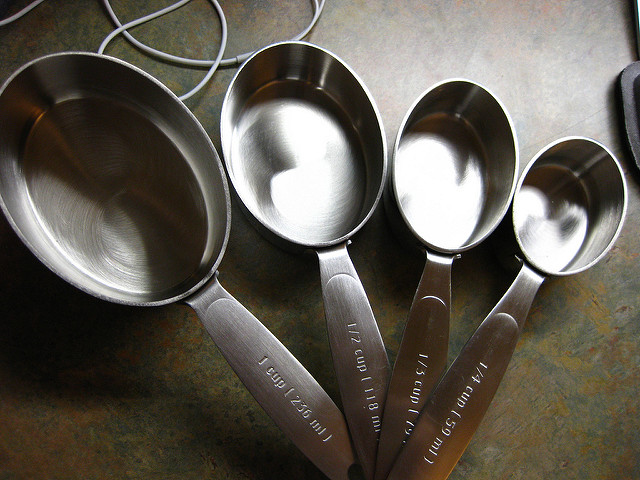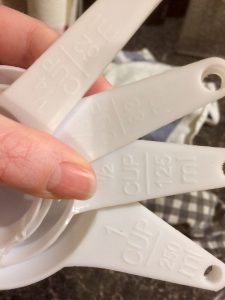There are a lot of things that differ from the US and Europe, and baking measurements is one of them. Each side has their own measurement system with benefits and pitfalls. With the ability to find recipes online and regardless of the geographic location, cooks have a new opportunity open to them. With the availability for expansion of cooking knowledge, comes confusion, either with cultural flavour pairings and the technical aspects of cooking. Having 2 different measurement systems can cause confusion for Europeans trying to cook recipes that have been created in the US. I hope to try and create a stop-gap for the technical questions which arise.
This post is going to be more of a bog standard FAQ’s page for cooking with cup measures and spoon measures. This is usually a technique which is used in North American cooking and can be confusing for Europeans (I have seen confusion first hand). It is apparently not clear that cup measurements are an actual exact amount, with prescribed measurements. You cannot just simply pull a mug out of your cupboard and go “huzzah, a cup!”
As a result, I have added in a guide to help go over the techniques for using cup measures and spoons. It is also good to note that imperial spoon measurements differ from US spoon measurements; I have used imperial spoon measures with American cup measure recipes and I do find that it still works.
However, I have cheekily added in some UK spoon measures which I did not expect to find (this will be useful for any North Americans who read this post and want to make a UK recipe that requires them). Most notably – dessert spoon measures, and honestly, by most notably, I mean the only one. If you have any further questions / comments, do let me know and I will add it and incorporate it into the post.
Why do I need to use the back of a knife to skim off the top?
You need to use a knife when getting a level of your cup and spoon measurements. It will become apparent as I go on, but you need to use a knife as it has a flat surface. Unlike a spoon, which you should not use, as it will cause issues.
How do I measure a cup of flour?
When you measure flour into cup measure you need to ensure that you do not pack down flour as it needs to have air, and use the back of a knife to skim off the top of the cup measure to have an accurate amount. (142)
How do I measure a cup of granulated sugar?
When you measure out granulated (and this is the same for salt, icing sugar, and other dry baking ingredients that do not need the air like flour) sugar add the sugar by a spoon or pour it directly into the cup measure. Use the back of a knife to level the top of the measure.
How do I measure a cup of brown sugar?
Measuring brown sugar into a cup measure is where the difference lies. You need to add the brown sugar into the cup and pack it down before adding more. The cup measure needs to have as much sugar packed into it to be accurate.
How big is a cup?
For fluids, a cup is 250 mls. As a result, if you do not have a cup measurement set, you can use a measuring jug. The US measurement is with volume rather than weight, so measuring correctly for the ingredient is important.
How big is an imperial dessert spoon?
Dessert spoons are ⅔ the size of a tablespoon and twice the size of a teaspoon in volume. For liquids that means that there are 10 mls for a dessert spoon, 15 for a tablespoon, 5mls for a teaspoon.
How big is an imperial tablespoon?
An imperial tablespoon is equal to 15mls. A tablespoon measurement is around the same size as a UK dessert spoon (that you eat with at the table), which is where the confusion lies. It is also the largest of the spoon sizes in the US spoon measurements.
How big is an imperial teaspoon?
An imperial teaspoon is equal to 5mls of fluid. In the majority of spoon measurement sets, there will be much smaller sizes of the imperial teaspoon. The size of the imperial teaspoon is somewhat similar to actual table teaspoons, and I have substituted for them in the past.
I hope that this was helpful! and if you find any other measurements and/or additions that I need to add, do let me know!

